Report on Use of Technology in Old Age People
VerifiedAdded on 2020/05/03
|9
|2576
|51
AI Summary
Contribute Materials
Your contribution can guide someone’s learning journey. Share your
documents today.
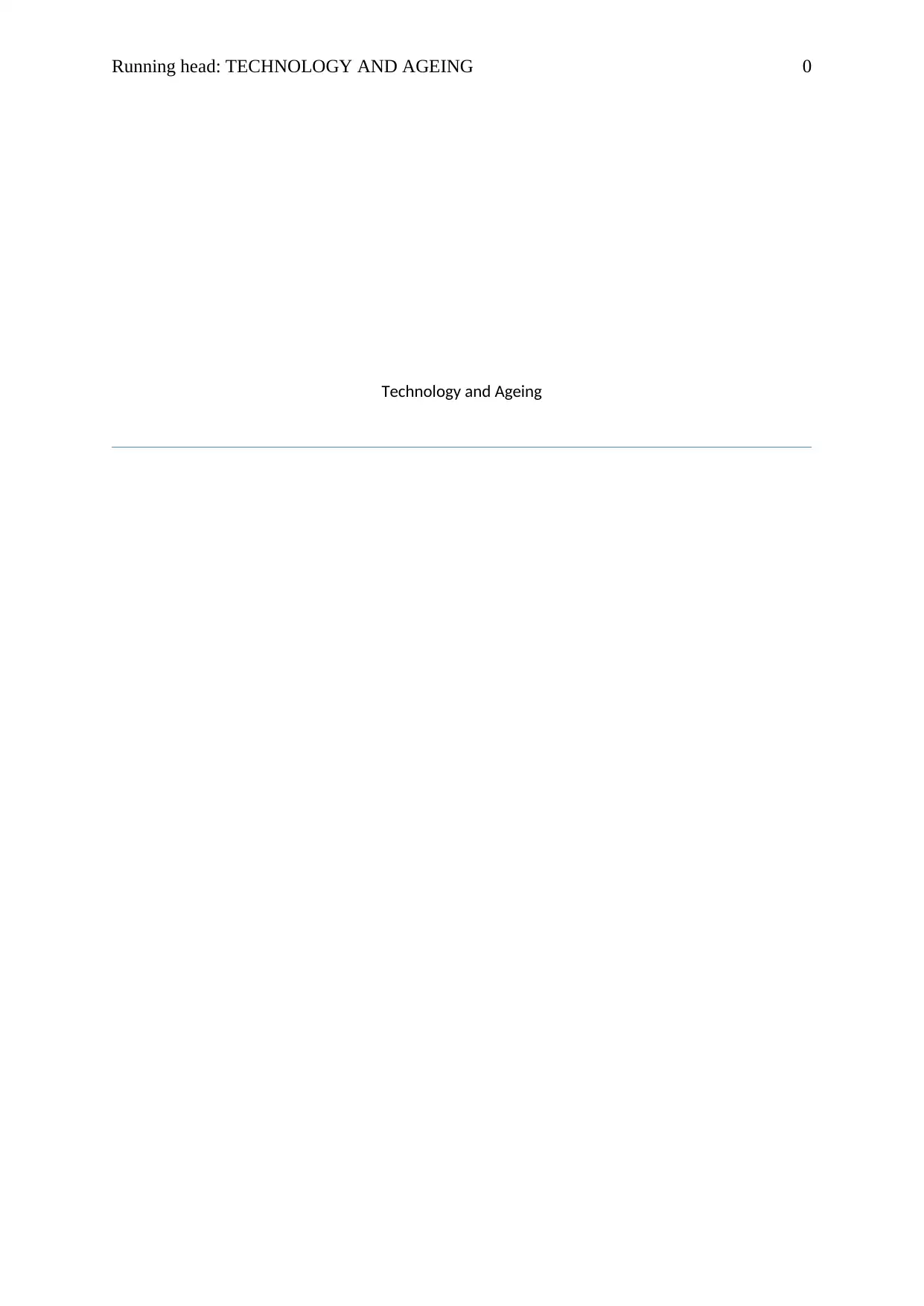
Running head: TECHNOLOGY AND AGEING 0
Technology and Ageing
Technology and Ageing
Secure Best Marks with AI Grader
Need help grading? Try our AI Grader for instant feedback on your assignments.
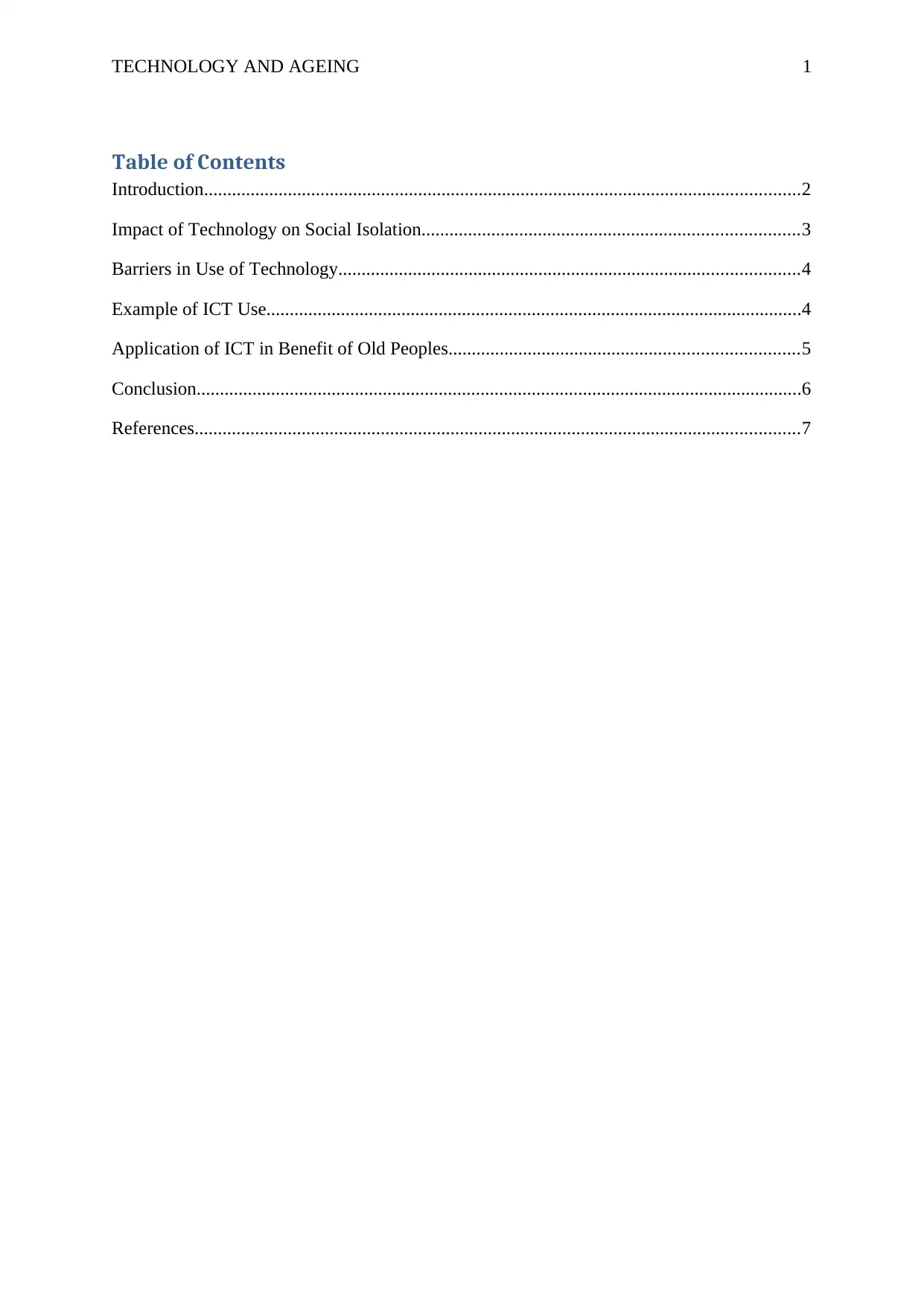
TECHNOLOGY AND AGEING 1
Table of Contents
Introduction................................................................................................................................2
Impact of Technology on Social Isolation.................................................................................3
Barriers in Use of Technology...................................................................................................4
Example of ICT Use...................................................................................................................4
Application of ICT in Benefit of Old Peoples...........................................................................5
Conclusion..................................................................................................................................6
References..................................................................................................................................7
Table of Contents
Introduction................................................................................................................................2
Impact of Technology on Social Isolation.................................................................................3
Barriers in Use of Technology...................................................................................................4
Example of ICT Use...................................................................................................................4
Application of ICT in Benefit of Old Peoples...........................................................................5
Conclusion..................................................................................................................................6
References..................................................................................................................................7
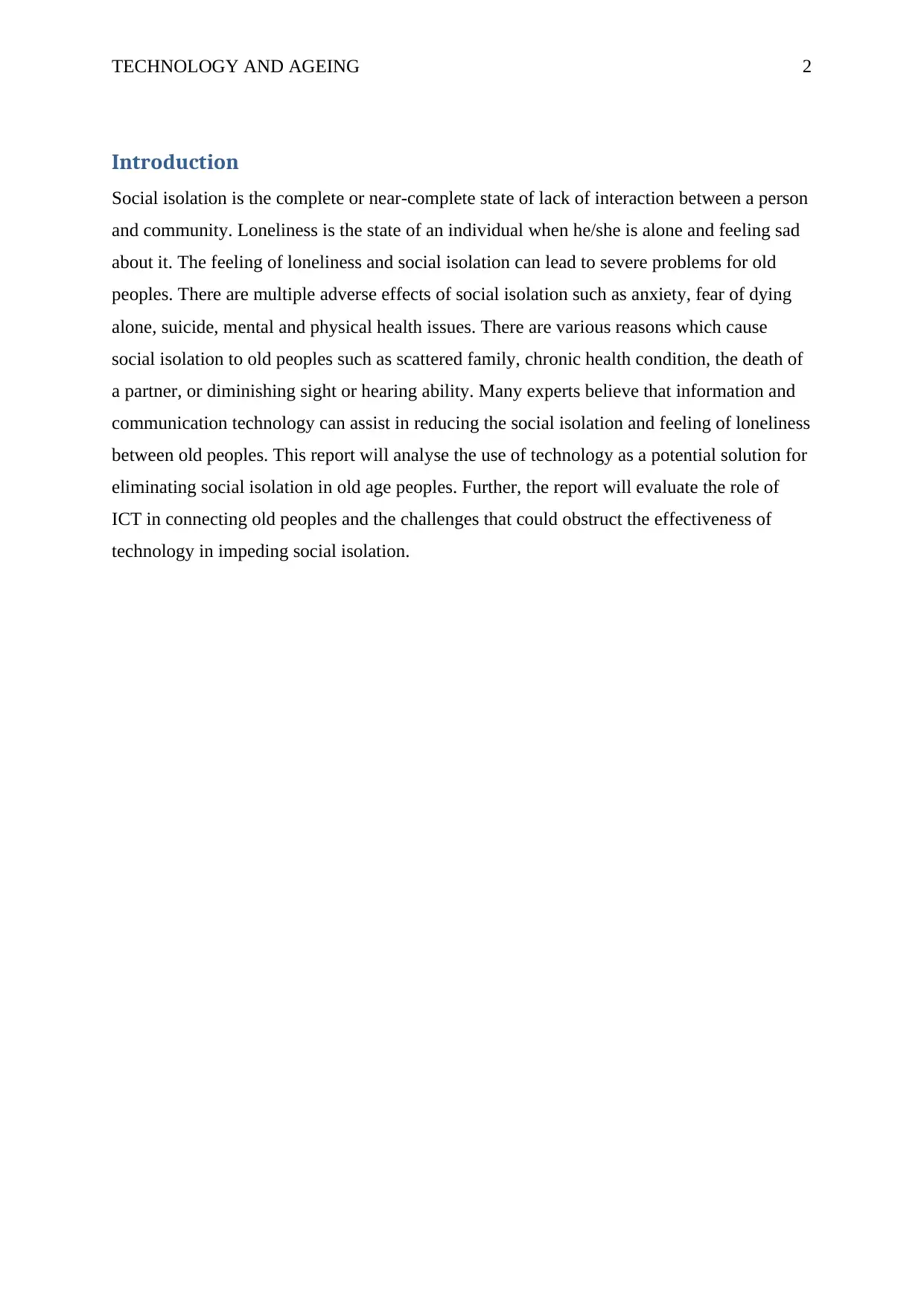
TECHNOLOGY AND AGEING 2
Introduction
Social isolation is the complete or near-complete state of lack of interaction between a person
and community. Loneliness is the state of an individual when he/she is alone and feeling sad
about it. The feeling of loneliness and social isolation can lead to severe problems for old
peoples. There are multiple adverse effects of social isolation such as anxiety, fear of dying
alone, suicide, mental and physical health issues. There are various reasons which cause
social isolation to old peoples such as scattered family, chronic health condition, the death of
a partner, or diminishing sight or hearing ability. Many experts believe that information and
communication technology can assist in reducing the social isolation and feeling of loneliness
between old peoples. This report will analyse the use of technology as a potential solution for
eliminating social isolation in old age peoples. Further, the report will evaluate the role of
ICT in connecting old peoples and the challenges that could obstruct the effectiveness of
technology in impeding social isolation.
Introduction
Social isolation is the complete or near-complete state of lack of interaction between a person
and community. Loneliness is the state of an individual when he/she is alone and feeling sad
about it. The feeling of loneliness and social isolation can lead to severe problems for old
peoples. There are multiple adverse effects of social isolation such as anxiety, fear of dying
alone, suicide, mental and physical health issues. There are various reasons which cause
social isolation to old peoples such as scattered family, chronic health condition, the death of
a partner, or diminishing sight or hearing ability. Many experts believe that information and
communication technology can assist in reducing the social isolation and feeling of loneliness
between old peoples. This report will analyse the use of technology as a potential solution for
eliminating social isolation in old age peoples. Further, the report will evaluate the role of
ICT in connecting old peoples and the challenges that could obstruct the effectiveness of
technology in impeding social isolation.
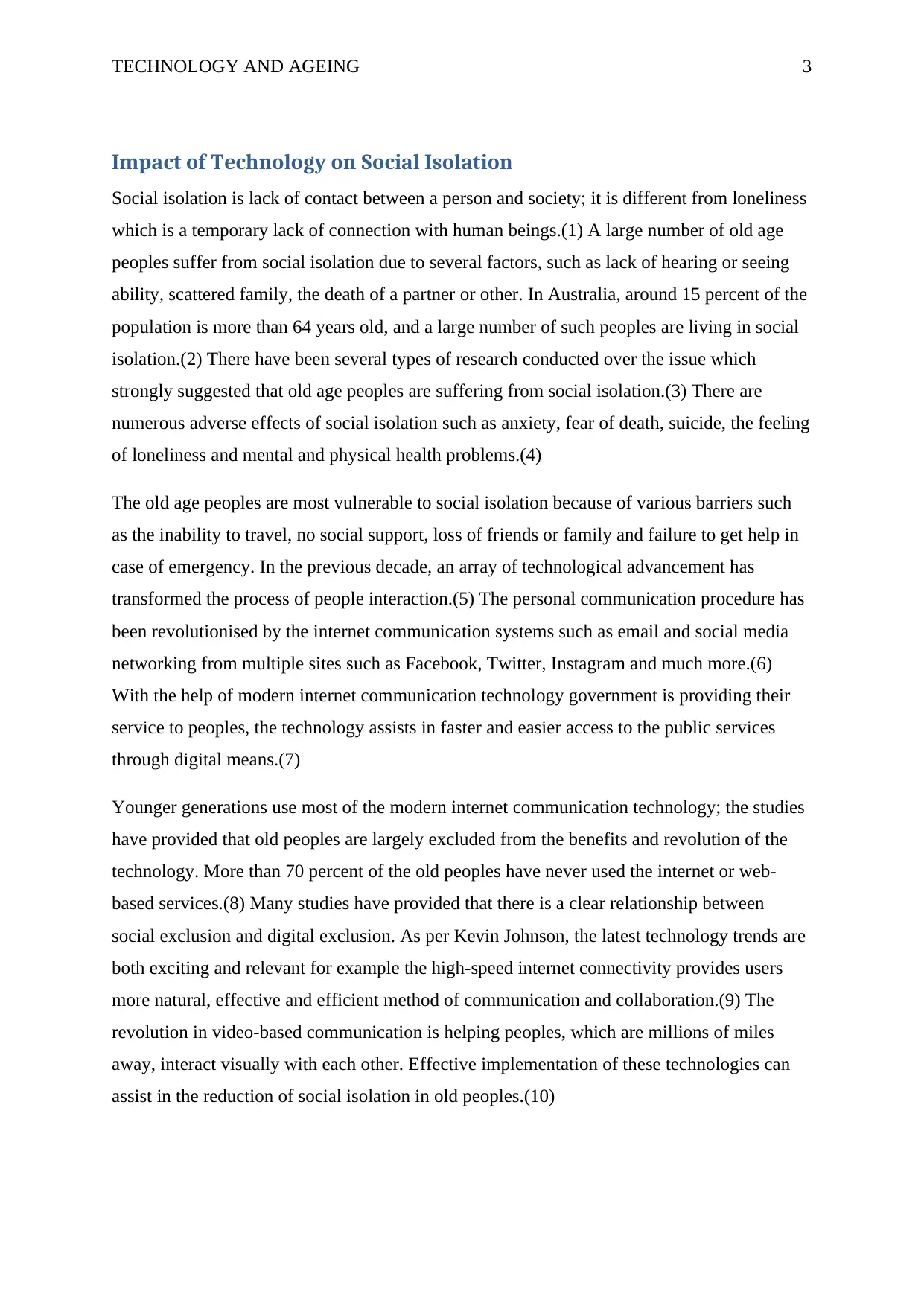
TECHNOLOGY AND AGEING 3
Impact of Technology on Social Isolation
Social isolation is lack of contact between a person and society; it is different from loneliness
which is a temporary lack of connection with human beings.(1) A large number of old age
peoples suffer from social isolation due to several factors, such as lack of hearing or seeing
ability, scattered family, the death of a partner or other. In Australia, around 15 percent of the
population is more than 64 years old, and a large number of such peoples are living in social
isolation.(2) There have been several types of research conducted over the issue which
strongly suggested that old age peoples are suffering from social isolation.(3) There are
numerous adverse effects of social isolation such as anxiety, fear of death, suicide, the feeling
of loneliness and mental and physical health problems.(4)
The old age peoples are most vulnerable to social isolation because of various barriers such
as the inability to travel, no social support, loss of friends or family and failure to get help in
case of emergency. In the previous decade, an array of technological advancement has
transformed the process of people interaction.(5) The personal communication procedure has
been revolutionised by the internet communication systems such as email and social media
networking from multiple sites such as Facebook, Twitter, Instagram and much more.(6)
With the help of modern internet communication technology government is providing their
service to peoples, the technology assists in faster and easier access to the public services
through digital means.(7)
Younger generations use most of the modern internet communication technology; the studies
have provided that old peoples are largely excluded from the benefits and revolution of the
technology. More than 70 percent of the old peoples have never used the internet or web-
based services.(8) Many studies have provided that there is a clear relationship between
social exclusion and digital exclusion. As per Kevin Johnson, the latest technology trends are
both exciting and relevant for example the high-speed internet connectivity provides users
more natural, effective and efficient method of communication and collaboration.(9) The
revolution in video-based communication is helping peoples, which are millions of miles
away, interact visually with each other. Effective implementation of these technologies can
assist in the reduction of social isolation in old peoples.(10)
Impact of Technology on Social Isolation
Social isolation is lack of contact between a person and society; it is different from loneliness
which is a temporary lack of connection with human beings.(1) A large number of old age
peoples suffer from social isolation due to several factors, such as lack of hearing or seeing
ability, scattered family, the death of a partner or other. In Australia, around 15 percent of the
population is more than 64 years old, and a large number of such peoples are living in social
isolation.(2) There have been several types of research conducted over the issue which
strongly suggested that old age peoples are suffering from social isolation.(3) There are
numerous adverse effects of social isolation such as anxiety, fear of death, suicide, the feeling
of loneliness and mental and physical health problems.(4)
The old age peoples are most vulnerable to social isolation because of various barriers such
as the inability to travel, no social support, loss of friends or family and failure to get help in
case of emergency. In the previous decade, an array of technological advancement has
transformed the process of people interaction.(5) The personal communication procedure has
been revolutionised by the internet communication systems such as email and social media
networking from multiple sites such as Facebook, Twitter, Instagram and much more.(6)
With the help of modern internet communication technology government is providing their
service to peoples, the technology assists in faster and easier access to the public services
through digital means.(7)
Younger generations use most of the modern internet communication technology; the studies
have provided that old peoples are largely excluded from the benefits and revolution of the
technology. More than 70 percent of the old peoples have never used the internet or web-
based services.(8) Many studies have provided that there is a clear relationship between
social exclusion and digital exclusion. As per Kevin Johnson, the latest technology trends are
both exciting and relevant for example the high-speed internet connectivity provides users
more natural, effective and efficient method of communication and collaboration.(9) The
revolution in video-based communication is helping peoples, which are millions of miles
away, interact visually with each other. Effective implementation of these technologies can
assist in the reduction of social isolation in old peoples.(10)
Secure Best Marks with AI Grader
Need help grading? Try our AI Grader for instant feedback on your assignments.
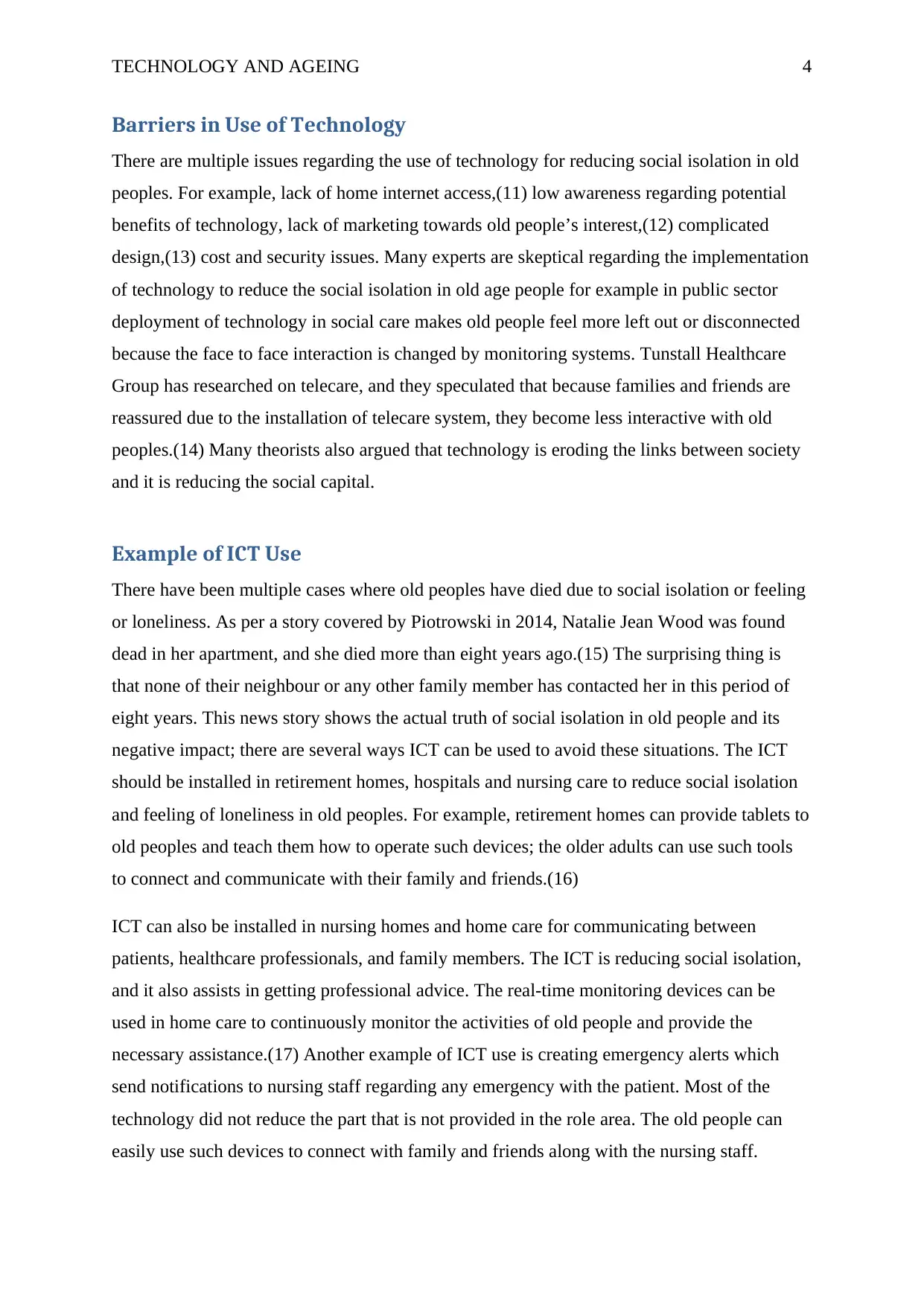
TECHNOLOGY AND AGEING 4
Barriers in Use of Technology
There are multiple issues regarding the use of technology for reducing social isolation in old
peoples. For example, lack of home internet access,(11) low awareness regarding potential
benefits of technology, lack of marketing towards old people’s interest,(12) complicated
design,(13) cost and security issues. Many experts are skeptical regarding the implementation
of technology to reduce the social isolation in old age people for example in public sector
deployment of technology in social care makes old people feel more left out or disconnected
because the face to face interaction is changed by monitoring systems. Tunstall Healthcare
Group has researched on telecare, and they speculated that because families and friends are
reassured due to the installation of telecare system, they become less interactive with old
peoples.(14) Many theorists also argued that technology is eroding the links between society
and it is reducing the social capital.
Example of ICT Use
There have been multiple cases where old peoples have died due to social isolation or feeling
or loneliness. As per a story covered by Piotrowski in 2014, Natalie Jean Wood was found
dead in her apartment, and she died more than eight years ago.(15) The surprising thing is
that none of their neighbour or any other family member has contacted her in this period of
eight years. This news story shows the actual truth of social isolation in old people and its
negative impact; there are several ways ICT can be used to avoid these situations. The ICT
should be installed in retirement homes, hospitals and nursing care to reduce social isolation
and feeling of loneliness in old peoples. For example, retirement homes can provide tablets to
old peoples and teach them how to operate such devices; the older adults can use such tools
to connect and communicate with their family and friends.(16)
ICT can also be installed in nursing homes and home care for communicating between
patients, healthcare professionals, and family members. The ICT is reducing social isolation,
and it also assists in getting professional advice. The real-time monitoring devices can be
used in home care to continuously monitor the activities of old people and provide the
necessary assistance.(17) Another example of ICT use is creating emergency alerts which
send notifications to nursing staff regarding any emergency with the patient. Most of the
technology did not reduce the part that is not provided in the role area. The old people can
easily use such devices to connect with family and friends along with the nursing staff.
Barriers in Use of Technology
There are multiple issues regarding the use of technology for reducing social isolation in old
peoples. For example, lack of home internet access,(11) low awareness regarding potential
benefits of technology, lack of marketing towards old people’s interest,(12) complicated
design,(13) cost and security issues. Many experts are skeptical regarding the implementation
of technology to reduce the social isolation in old age people for example in public sector
deployment of technology in social care makes old people feel more left out or disconnected
because the face to face interaction is changed by monitoring systems. Tunstall Healthcare
Group has researched on telecare, and they speculated that because families and friends are
reassured due to the installation of telecare system, they become less interactive with old
peoples.(14) Many theorists also argued that technology is eroding the links between society
and it is reducing the social capital.
Example of ICT Use
There have been multiple cases where old peoples have died due to social isolation or feeling
or loneliness. As per a story covered by Piotrowski in 2014, Natalie Jean Wood was found
dead in her apartment, and she died more than eight years ago.(15) The surprising thing is
that none of their neighbour or any other family member has contacted her in this period of
eight years. This news story shows the actual truth of social isolation in old people and its
negative impact; there are several ways ICT can be used to avoid these situations. The ICT
should be installed in retirement homes, hospitals and nursing care to reduce social isolation
and feeling of loneliness in old peoples. For example, retirement homes can provide tablets to
old peoples and teach them how to operate such devices; the older adults can use such tools
to connect and communicate with their family and friends.(16)
ICT can also be installed in nursing homes and home care for communicating between
patients, healthcare professionals, and family members. The ICT is reducing social isolation,
and it also assists in getting professional advice. The real-time monitoring devices can be
used in home care to continuously monitor the activities of old people and provide the
necessary assistance.(17) Another example of ICT use is creating emergency alerts which
send notifications to nursing staff regarding any emergency with the patient. Most of the
technology did not reduce the part that is not provided in the role area. The old people can
easily use such devices to connect with family and friends along with the nursing staff.
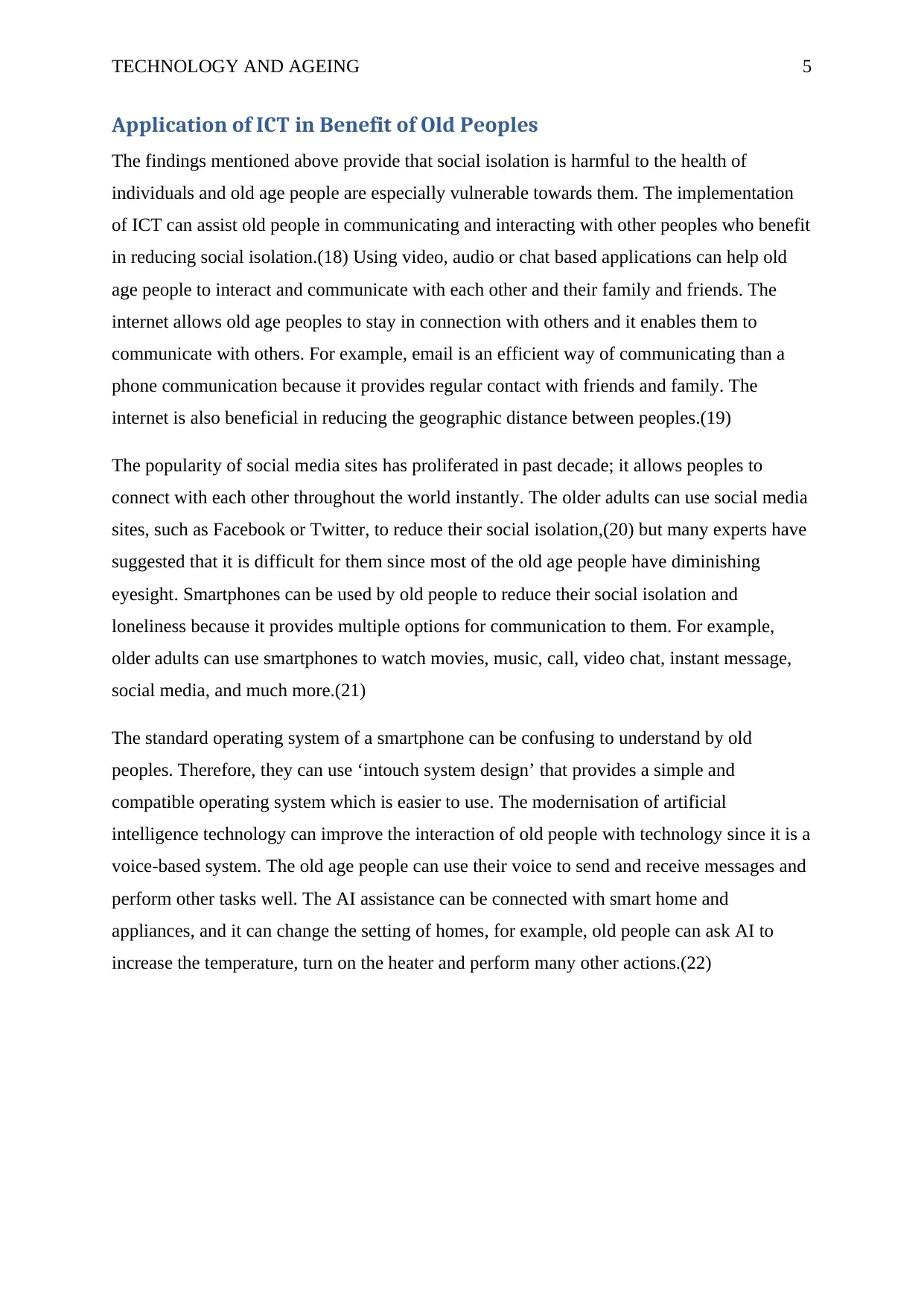
TECHNOLOGY AND AGEING 5
Application of ICT in Benefit of Old Peoples
The findings mentioned above provide that social isolation is harmful to the health of
individuals and old age people are especially vulnerable towards them. The implementation
of ICT can assist old people in communicating and interacting with other peoples who benefit
in reducing social isolation.(18) Using video, audio or chat based applications can help old
age people to interact and communicate with each other and their family and friends. The
internet allows old age peoples to stay in connection with others and it enables them to
communicate with others. For example, email is an efficient way of communicating than a
phone communication because it provides regular contact with friends and family. The
internet is also beneficial in reducing the geographic distance between peoples.(19)
The popularity of social media sites has proliferated in past decade; it allows peoples to
connect with each other throughout the world instantly. The older adults can use social media
sites, such as Facebook or Twitter, to reduce their social isolation,(20) but many experts have
suggested that it is difficult for them since most of the old age people have diminishing
eyesight. Smartphones can be used by old people to reduce their social isolation and
loneliness because it provides multiple options for communication to them. For example,
older adults can use smartphones to watch movies, music, call, video chat, instant message,
social media, and much more.(21)
The standard operating system of a smartphone can be confusing to understand by old
peoples. Therefore, they can use ‘intouch system design’ that provides a simple and
compatible operating system which is easier to use. The modernisation of artificial
intelligence technology can improve the interaction of old people with technology since it is a
voice-based system. The old age people can use their voice to send and receive messages and
perform other tasks well. The AI assistance can be connected with smart home and
appliances, and it can change the setting of homes, for example, old people can ask AI to
increase the temperature, turn on the heater and perform many other actions.(22)
Application of ICT in Benefit of Old Peoples
The findings mentioned above provide that social isolation is harmful to the health of
individuals and old age people are especially vulnerable towards them. The implementation
of ICT can assist old people in communicating and interacting with other peoples who benefit
in reducing social isolation.(18) Using video, audio or chat based applications can help old
age people to interact and communicate with each other and their family and friends. The
internet allows old age peoples to stay in connection with others and it enables them to
communicate with others. For example, email is an efficient way of communicating than a
phone communication because it provides regular contact with friends and family. The
internet is also beneficial in reducing the geographic distance between peoples.(19)
The popularity of social media sites has proliferated in past decade; it allows peoples to
connect with each other throughout the world instantly. The older adults can use social media
sites, such as Facebook or Twitter, to reduce their social isolation,(20) but many experts have
suggested that it is difficult for them since most of the old age people have diminishing
eyesight. Smartphones can be used by old people to reduce their social isolation and
loneliness because it provides multiple options for communication to them. For example,
older adults can use smartphones to watch movies, music, call, video chat, instant message,
social media, and much more.(21)
The standard operating system of a smartphone can be confusing to understand by old
peoples. Therefore, they can use ‘intouch system design’ that provides a simple and
compatible operating system which is easier to use. The modernisation of artificial
intelligence technology can improve the interaction of old people with technology since it is a
voice-based system. The old age people can use their voice to send and receive messages and
perform other tasks well. The AI assistance can be connected with smart home and
appliances, and it can change the setting of homes, for example, old people can ask AI to
increase the temperature, turn on the heater and perform many other actions.(22)
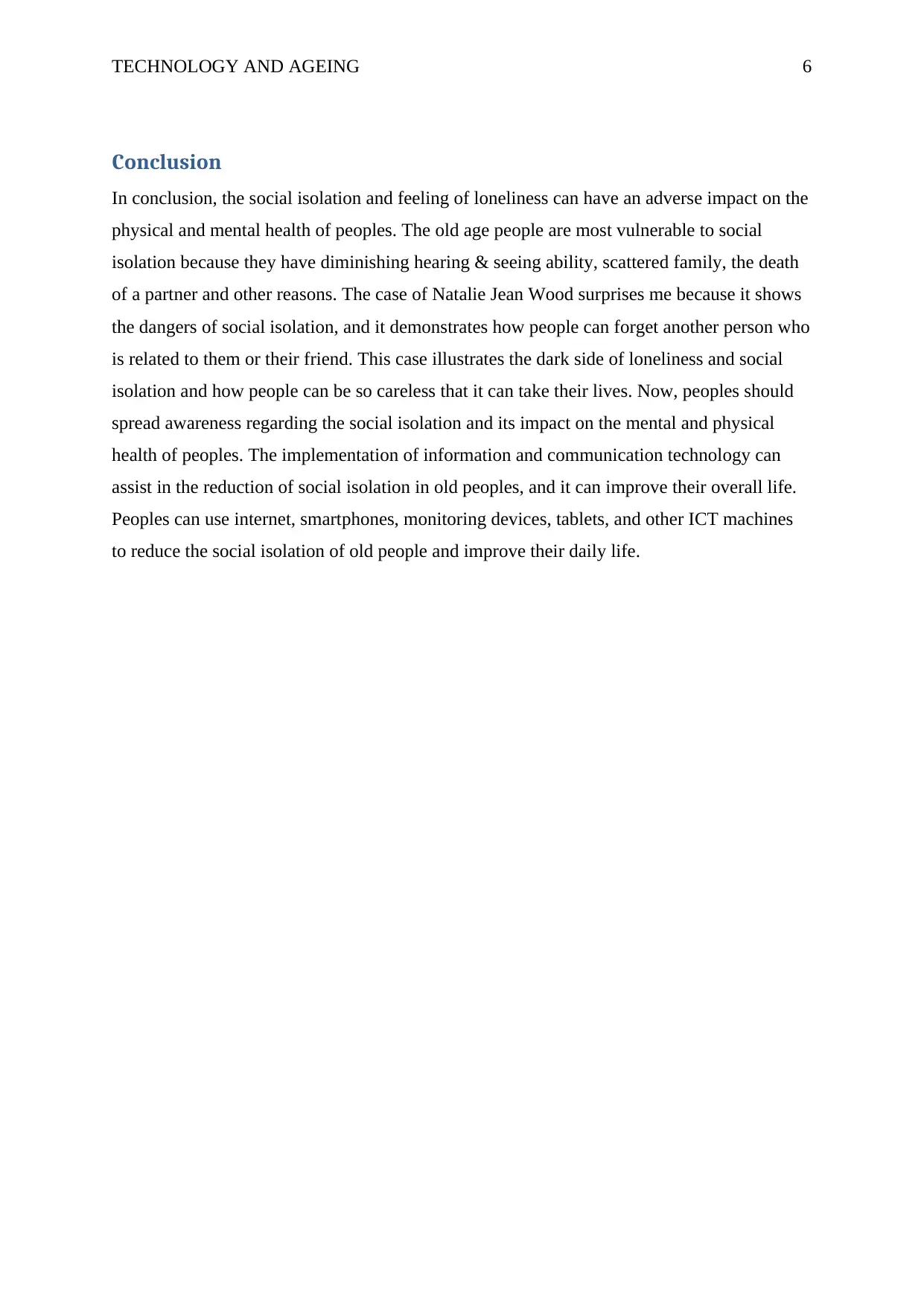
TECHNOLOGY AND AGEING 6
Conclusion
In conclusion, the social isolation and feeling of loneliness can have an adverse impact on the
physical and mental health of peoples. The old age people are most vulnerable to social
isolation because they have diminishing hearing & seeing ability, scattered family, the death
of a partner and other reasons. The case of Natalie Jean Wood surprises me because it shows
the dangers of social isolation, and it demonstrates how people can forget another person who
is related to them or their friend. This case illustrates the dark side of loneliness and social
isolation and how people can be so careless that it can take their lives. Now, peoples should
spread awareness regarding the social isolation and its impact on the mental and physical
health of peoples. The implementation of information and communication technology can
assist in the reduction of social isolation in old peoples, and it can improve their overall life.
Peoples can use internet, smartphones, monitoring devices, tablets, and other ICT machines
to reduce the social isolation of old people and improve their daily life.
Conclusion
In conclusion, the social isolation and feeling of loneliness can have an adverse impact on the
physical and mental health of peoples. The old age people are most vulnerable to social
isolation because they have diminishing hearing & seeing ability, scattered family, the death
of a partner and other reasons. The case of Natalie Jean Wood surprises me because it shows
the dangers of social isolation, and it demonstrates how people can forget another person who
is related to them or their friend. This case illustrates the dark side of loneliness and social
isolation and how people can be so careless that it can take their lives. Now, peoples should
spread awareness regarding the social isolation and its impact on the mental and physical
health of peoples. The implementation of information and communication technology can
assist in the reduction of social isolation in old peoples, and it can improve their overall life.
Peoples can use internet, smartphones, monitoring devices, tablets, and other ICT machines
to reduce the social isolation of old people and improve their daily life.
Paraphrase This Document
Need a fresh take? Get an instant paraphrase of this document with our AI Paraphraser
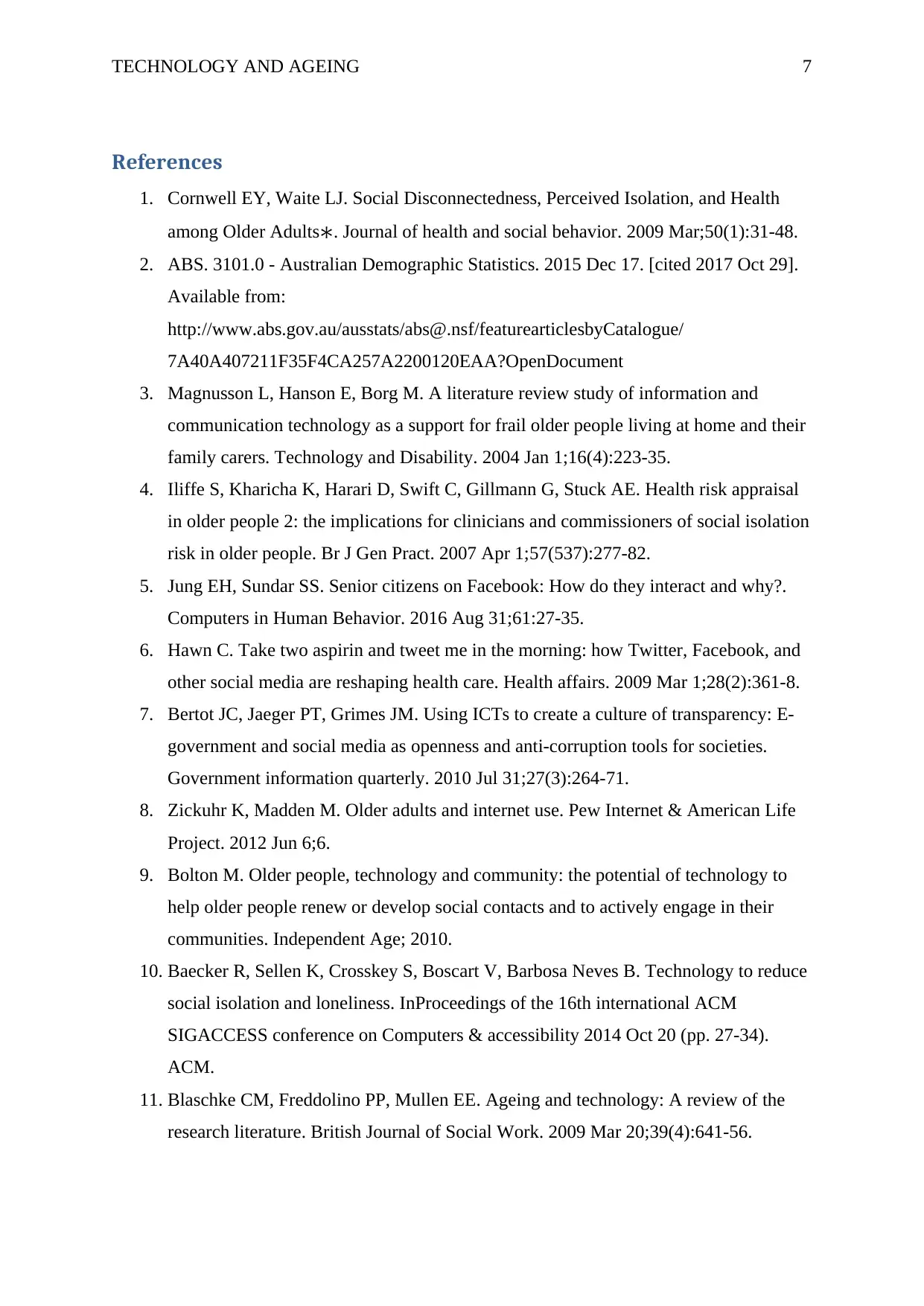
TECHNOLOGY AND AGEING 7
References
1. Cornwell EY, Waite LJ. Social Disconnectedness, Perceived Isolation, and Health
among Older Adults∗. Journal of health and social behavior. 2009 Mar;50(1):31-48.
2. ABS. 3101.0 - Australian Demographic Statistics. 2015 Dec 17. [cited 2017 Oct 29].
Available from:
http://www.abs.gov.au/ausstats/abs@.nsf/featurearticlesbyCatalogue/
7A40A407211F35F4CA257A2200120EAA?OpenDocument
3. Magnusson L, Hanson E, Borg M. A literature review study of information and
communication technology as a support for frail older people living at home and their
family carers. Technology and Disability. 2004 Jan 1;16(4):223-35.
4. Iliffe S, Kharicha K, Harari D, Swift C, Gillmann G, Stuck AE. Health risk appraisal
in older people 2: the implications for clinicians and commissioners of social isolation
risk in older people. Br J Gen Pract. 2007 Apr 1;57(537):277-82.
5. Jung EH, Sundar SS. Senior citizens on Facebook: How do they interact and why?.
Computers in Human Behavior. 2016 Aug 31;61:27-35.
6. Hawn C. Take two aspirin and tweet me in the morning: how Twitter, Facebook, and
other social media are reshaping health care. Health affairs. 2009 Mar 1;28(2):361-8.
7. Bertot JC, Jaeger PT, Grimes JM. Using ICTs to create a culture of transparency: E-
government and social media as openness and anti-corruption tools for societies.
Government information quarterly. 2010 Jul 31;27(3):264-71.
8. Zickuhr K, Madden M. Older adults and internet use. Pew Internet & American Life
Project. 2012 Jun 6;6.
9. Bolton M. Older people, technology and community: the potential of technology to
help older people renew or develop social contacts and to actively engage in their
communities. Independent Age; 2010.
10. Baecker R, Sellen K, Crosskey S, Boscart V, Barbosa Neves B. Technology to reduce
social isolation and loneliness. InProceedings of the 16th international ACM
SIGACCESS conference on Computers & accessibility 2014 Oct 20 (pp. 27-34).
ACM.
11. Blaschke CM, Freddolino PP, Mullen EE. Ageing and technology: A review of the
research literature. British Journal of Social Work. 2009 Mar 20;39(4):641-56.
References
1. Cornwell EY, Waite LJ. Social Disconnectedness, Perceived Isolation, and Health
among Older Adults∗. Journal of health and social behavior. 2009 Mar;50(1):31-48.
2. ABS. 3101.0 - Australian Demographic Statistics. 2015 Dec 17. [cited 2017 Oct 29].
Available from:
http://www.abs.gov.au/ausstats/abs@.nsf/featurearticlesbyCatalogue/
7A40A407211F35F4CA257A2200120EAA?OpenDocument
3. Magnusson L, Hanson E, Borg M. A literature review study of information and
communication technology as a support for frail older people living at home and their
family carers. Technology and Disability. 2004 Jan 1;16(4):223-35.
4. Iliffe S, Kharicha K, Harari D, Swift C, Gillmann G, Stuck AE. Health risk appraisal
in older people 2: the implications for clinicians and commissioners of social isolation
risk in older people. Br J Gen Pract. 2007 Apr 1;57(537):277-82.
5. Jung EH, Sundar SS. Senior citizens on Facebook: How do they interact and why?.
Computers in Human Behavior. 2016 Aug 31;61:27-35.
6. Hawn C. Take two aspirin and tweet me in the morning: how Twitter, Facebook, and
other social media are reshaping health care. Health affairs. 2009 Mar 1;28(2):361-8.
7. Bertot JC, Jaeger PT, Grimes JM. Using ICTs to create a culture of transparency: E-
government and social media as openness and anti-corruption tools for societies.
Government information quarterly. 2010 Jul 31;27(3):264-71.
8. Zickuhr K, Madden M. Older adults and internet use. Pew Internet & American Life
Project. 2012 Jun 6;6.
9. Bolton M. Older people, technology and community: the potential of technology to
help older people renew or develop social contacts and to actively engage in their
communities. Independent Age; 2010.
10. Baecker R, Sellen K, Crosskey S, Boscart V, Barbosa Neves B. Technology to reduce
social isolation and loneliness. InProceedings of the 16th international ACM
SIGACCESS conference on Computers & accessibility 2014 Oct 20 (pp. 27-34).
ACM.
11. Blaschke CM, Freddolino PP, Mullen EE. Ageing and technology: A review of the
research literature. British Journal of Social Work. 2009 Mar 20;39(4):641-56.

TECHNOLOGY AND AGEING 8
12. Eastman JK, Iyer R. The elderly's uses and attitudes towards the Internet. Journal of
Consumer Marketing. 2004 May 1;21(3):208-20.
13. Oudshoorn N, Rommes E, Stienstra M. Configuring the user as everybody: Gender
and design cultures in information and communication technologies. Science,
Technology, & Human Values. 2004 Jan;29(1):30-63.
14. Doughty K. Extending the Role of Telecare and Assistive Technologies in Supporting
Vulnerable Groups in the Community. InThe Home and Electronic Assistive
Technology Workshop”, York, March 16-17 th, 2004 2004 (p. 43).
15. Piotrowski D. Coronial inquest hears testimony about the lonely life of 'the woman
Sydney forgot', Natalie Jean Wood. NEWS. 2014 February 6. [cited 2017 Oct 29].
Available from: http://www.news.com.au/national/coronial-inquest-hears-testimony-
about-the-lonely-life-of-the-woman-sydney-forgot-natalie-jean-wood/news-story/
a99d9665f618e5a0c45ff117cb62dcd9
16. Otjacques B, Krier M, Feltz F, Ferring D, Hoffmann M. Helping older people to
manage their social activities at the retirement home. InProceedings of the 23rd
British HCI Group Annual Conference on People and Computers: Celebrating People
and Technology 2009 Sep 1 (pp. 375-380). British Computer Society.
17. Eveborn P, Rönnqvist M, Einarsdóttir H, Eklund M, Lidén K, Almroth M. Operations
research improves quality and efficiency in home care. Interfaces. 2009 Feb;39(1):18-
34.
18. Prendergast D, Garattini C, editors. Aging and the digital life course. Berghahn
Books; 2015 Jun 30.
19. Garattini C, Wherton J, Prendergast D. Linking the lonely: an exploration of a
communication technology designed to support social interaction among older adults.
Universal access in the information society. 2012 Jun 1;11(2):211-22.
20. Unwin PT, editor. ICT4D: Information and communication technology for
development. Cambridge University Press; 2009 Feb 9.
21. Neves BB, Franz RL, Munteanu C, Baecker R. Adoption and feasibility of a
communication app to enhance social connectedness amongst frail institutionalized
oldest old: an embedded case study. Information, Communication & Society. 2017 Jul
11:1-9.
22. Pollack ME. Intelligent technology for an aging population: The use of AI to assist
elders with cognitive impairment. AI magazine. 2005 Jun 15;26(2):9.
12. Eastman JK, Iyer R. The elderly's uses and attitudes towards the Internet. Journal of
Consumer Marketing. 2004 May 1;21(3):208-20.
13. Oudshoorn N, Rommes E, Stienstra M. Configuring the user as everybody: Gender
and design cultures in information and communication technologies. Science,
Technology, & Human Values. 2004 Jan;29(1):30-63.
14. Doughty K. Extending the Role of Telecare and Assistive Technologies in Supporting
Vulnerable Groups in the Community. InThe Home and Electronic Assistive
Technology Workshop”, York, March 16-17 th, 2004 2004 (p. 43).
15. Piotrowski D. Coronial inquest hears testimony about the lonely life of 'the woman
Sydney forgot', Natalie Jean Wood. NEWS. 2014 February 6. [cited 2017 Oct 29].
Available from: http://www.news.com.au/national/coronial-inquest-hears-testimony-
about-the-lonely-life-of-the-woman-sydney-forgot-natalie-jean-wood/news-story/
a99d9665f618e5a0c45ff117cb62dcd9
16. Otjacques B, Krier M, Feltz F, Ferring D, Hoffmann M. Helping older people to
manage their social activities at the retirement home. InProceedings of the 23rd
British HCI Group Annual Conference on People and Computers: Celebrating People
and Technology 2009 Sep 1 (pp. 375-380). British Computer Society.
17. Eveborn P, Rönnqvist M, Einarsdóttir H, Eklund M, Lidén K, Almroth M. Operations
research improves quality and efficiency in home care. Interfaces. 2009 Feb;39(1):18-
34.
18. Prendergast D, Garattini C, editors. Aging and the digital life course. Berghahn
Books; 2015 Jun 30.
19. Garattini C, Wherton J, Prendergast D. Linking the lonely: an exploration of a
communication technology designed to support social interaction among older adults.
Universal access in the information society. 2012 Jun 1;11(2):211-22.
20. Unwin PT, editor. ICT4D: Information and communication technology for
development. Cambridge University Press; 2009 Feb 9.
21. Neves BB, Franz RL, Munteanu C, Baecker R. Adoption and feasibility of a
communication app to enhance social connectedness amongst frail institutionalized
oldest old: an embedded case study. Information, Communication & Society. 2017 Jul
11:1-9.
22. Pollack ME. Intelligent technology for an aging population: The use of AI to assist
elders with cognitive impairment. AI magazine. 2005 Jun 15;26(2):9.
1 out of 9
Related Documents
Your All-in-One AI-Powered Toolkit for Academic Success.
+13062052269
info@desklib.com
Available 24*7 on WhatsApp / Email
![[object Object]](/_next/static/media/star-bottom.7253800d.svg)
Unlock your academic potential
© 2024 | Zucol Services PVT LTD | All rights reserved.





